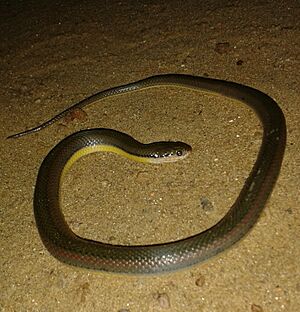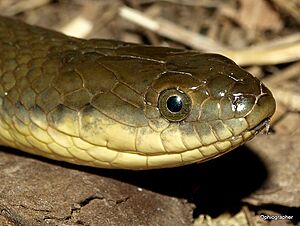Split keelback facts for kids
Quick facts for kids Split keelback |
|
|---|---|
 |
|
| Conservation status | |
| Scientific classification | |
| Genus: |
Atretium
|
| Species: |
schistosum
|
The Olive Keelback (scientific name: Atretium schistosum) is a type of snake. People also call it the split keelback or olive keelback wart snake. You can find this snake in South Asia. It is a very common water snake and it is not harmful to humans.
Contents
Where the Olive Keelback Lives
You can find the Olive Keelback in several countries. These include Sri Lanka, India, Bangladesh, and Nepal.
In India, it lives in the southern part. It is also found along the east coast up to Uttarakhand. This snake is very common in places like Bangalore and the North Arcot district in Tamil Nadu. You can also see it often in the Kakinada area of Andhra Pradesh.
These snakes can live in areas up to 1,000 meters (about 3,280 feet) above sea level. However, you will not find them in most parts of North India.
What the Olive Keelback Looks Like
The Olive Keelback is a small, strong snake. It has a thin head and a short snout. Its nostrils are placed a bit high up.
The snake's body is usually olive-green on top. Its belly is yellow to orange. Sometimes, its sides have a pink or purplish color. The tail of this snake is about one-third or one-fourth of its total body length.
The scales on its body feel rough. This is because they have a raised ridge, which is called a "keel." Snakes from South India often have a reddish line. This line runs along certain scales on their sides. It is brighter in male snakes.
Female Olive Keelbacks are usually between 70 and 75 centimeters (about 27-30 inches) long. Males are a bit smaller, measuring 50 to 60 centimeters (about 20-24 inches). The longest Olive Keelback ever measured was 87 centimeters (about 34 inches) long.
You will often find these snakes near water. They also like to hide in the plants around watery areas.
How to Identify an Olive Keelback
You can tell an Olive Keelback apart by looking at its scales. Here are some key features:
- It has a single scale between its nostrils, called an internasal scale.
- There are 19 rows of scales on its body, known as costal scales.
- It has 8 or 9 scales on its upper lip, called supralabial scales.
It can sometimes be confused with another snake, the olive forest snake (Rhabdops olivaceus).
Olive Keelback Habits
The Olive Keelback lives in water or among the plants near water.
This snake is usually active during the day. However, you might also see it at night. If you try to handle these snakes, they rarely bite. During hot summer months, they are known to aestivate. This means they go into a sleepy state to save energy.
The Olive Keelback mainly eats frogs, tadpoles, fish, and crabs. It catches its food in a special way. It swims past its prey and then quickly snaps its head to the side. This is a common hunting method for water snakes. The Olive Keelback is also known to eat mosquito larvae.
Sometimes, people mistakenly call this snake a "water-cobra." But even so, people usually do not harm it.
Reproduction and Life Cycle
The Olive Keelback lays eggs, which means it is an oviparous snake. It usually breeds during the monsoon season.
The eggs are white and soft. They are about 30 to 35 millimeters (about 1.2-1.4 inches) long. A female snake lays a group of eggs, called a clutch. A clutch can have anywhere from 10 to 32 eggs. They are laid between January and April. When the baby snakes hatch, they are about 16.6 to 17.5 centimeters (about 6.5-6.9 inches) long.
Local Names
Here are some names for the Olive Keelback in different local languages:



